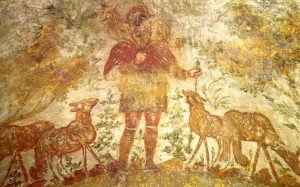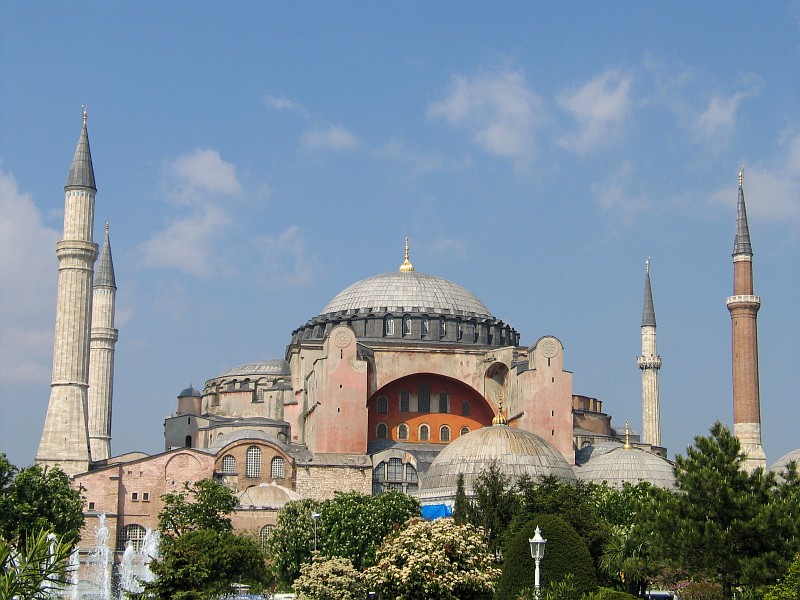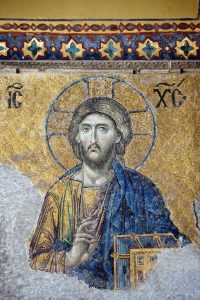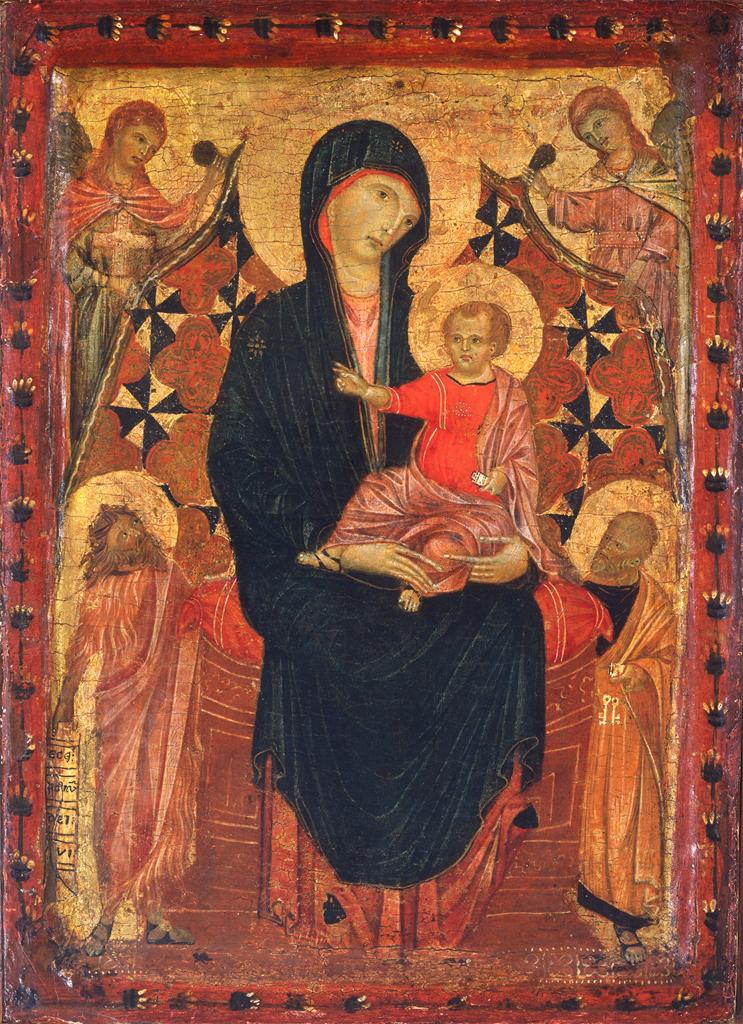2.3 Byzantine and Medieval Art: Teaching Christianity
In the century before Christ, Rome displaced the dominance of Seleucid and Ptolemaic Greek empires. Yet Roman culture was largely shaped by Greek influence. For example, Roman art absorbed and emulated Hellenistic models. Indeed, we know many Greek pieces as Roman copies. For example, scholars still debate whether Laocoön is a Greek original or a Roman copy.
And then came Christianity. Unlike Judaism, Christianity affirms a physically incarnate God. It reinterpreted the Jewish abhorrence of idolatry to permit images of the Christ. Early Christian art reflected the ethos of small churches that met in private homes and tended to the needs of humble people, especially women and slaves. The Savior was inscribed as a humble shepherd into the walls and ceilings of burial catacombs outside Rome.
 |
 |
| Christ as the Good Shepherd. (3rd C). Fresco. Catacomb of Priscilla | Christ as the Good Shepherd. (3rd Century). Catacomb of Domitilla. Fresco. |
In the early 4th Century, however, an alliance between the Roman Emperor Constantine changed the world, the church, and Western art. Imperial bishops demanded that all aspects of life, including art, focus on Christian themes. Constantinople, the new imperial capital, honored emperors, Christ, and the Virgin mother in a Byzantine style. In the 6th Century, the Emperor Justinian rebuilt the Cathedral of Constantinople, the seat of imperial church authority. Hagia Sophia (The church of Holy Wisdom) was one of the grandest buildings on earth with the largest dome. It testified to God’s grandeur, but probably more to the power of the Empire that now equated its interests with Christ’s.
 |
 |
| Hagia Sophia. 6th C. Constantinople (Istanbul, Turkey) | Christ Pantocrator. Mosaic. |
The interior of Hagia Sophia was richly decorated with …
The mosaics of Hagia Sophia would set the standard for centuries of Byzantine Art throughout the Christianized Empire and Medieval Europe. Byzantine artists were constrained by church and empire to focus solely on instructing the faithful in theology and worship. Byzantine art was strongly Didactic.
This spiritual and theological purpose can be seen in the Byzantine Icon: a Christian image of Jesus, Mary, or a saint who had earned special favor with God. Icons decorated churches, instructed often believers in the faith, and focused worship and rituals.
In the aftermath of the alliance between emperors and bishops, Christian faithfulness had also come to mean fidelity to the Empire. You can see this fusion in Byzantine images, in which Christ the humble shepherd becomes Christ the emperor, robed in purple, the emperor’s color. As early as the 3rd Century, Mary is celebrated as the Queen of Heaven. In “Madonna” images from Asia Minor to Ireland, the Virgin sits on an imperial throne, her divine child on her lap.
 |
| Virgin and Child. Mary as Queen of Heaven. Mosaic, Hagia Sophia. |
Recall that Didactic Art generally develops a fixed Stylized technique that focuses on communicating an unchanging message. Indeed, for more than 1,000 years, the distinctive Byzantine style dominated art throughout Europe, Western Asia, and northern Africa. Focused on worship and theology, a Byzantine image is composed in a static, timeless, placeless present. Unlike Classical Greek art, it has no interest Mimesis, Ideal human forms or the illusion of action through Rhythmos.
The stylistic result is an image in a flat plane with little attention to depth. The figures are abstractions with little individuality. They do not move, display little emotion and are not placed in any particular time or place. Transcending time, a single composition will combine images of Mary and the Christ child with those of saints who lived centuries later.
Remarkably, this style survived the 5th Century collapse of Imperial rule in the West—basically, Europe. Migrating Germanic tribal chieftains assumed control of local lands, converted to Christianity, and adopted the titles of the old Empire. With little interest in the Classical tradition of learning, hoiwever, they delegated to monks and bishops the tasks of administration and law.
As European knowledge of Greek dissipated, all but a tiny portion of Classical learning was lost to the West for roughly 1,000 years. Church scholars monopolized Latin learning (see below the illustration of Ezra the scribe) and the churches monopolized art. Anonymous artists designed and decorated churches, created altar pieces for worship, and illustrated Bibles and prayer books.
 |
 |
 |
| Ezra the scribe. (7th Century). Book illustration. | Saints Peter, Hermagoras, Fortunatus. (c. 1180). Fresco. | Cimabue. (c. 1290). Madonna and Child with Saint John the Baptist and Saint Peter. Tempera on panel. |
For centuries, European artists commissioned by the Church followed Byzantine conventions. The 12th Century image of St. Peter and two later saints affirms the passing of divine authority from generation to generation. Cimabue’s 13th Century depiction of the Holy Mother and Child, 1.000 years after the alliance of Empire and Church, achieves Byzantine effects with Tempera and wood: flat, expressionless, timeless, wholly theological icons. By the 14th Century, European art had strayed very far from its roots in Classical Greece. That was about to change.
References
Christ as the Good Shepherd [Fresco]. (3rd Century). Catacomb of Domitilla. Fresco. Rome, Italy. Wikipedia https://en.m.wikipedia.org/wiki/File:Good_Shepherd_04.jpg.
Christ as the Good Shepherd. [Fresco]. (3rd century). Good Shepherd Cubiculum of the Donna Velata, Rome, Italy: Catacomb of Priscilla. ARTstor https://library-artstor-org.ezproxy.bethel.edu/asset/SCALA_ARCHIVES_10310196962.
Christ Pantocrator. (532-537 CE). Hagia Sophia. [Mosaic]. Istanbul, Turkey: ARTstor https://library-artstor-org.ezproxy.bethel.edu/#/asset/ASITESPHOTOIG_10313843105;prevRouteTS=1544900589692.
Ezra the scribe. [Illustration] (692). Folio 5r from the Codex Amiatinus. Florence, Italy: Biblioteca Medicea Laurenziana, MS Amiatinus. Wikimedia https://commons.wikimedia.org/wiki/File:CodxAmiatinusFolio5rEzra.jpg.
Hagia Sophia. (532-537 CE). Istanbul, Turkey. Wikimedia https://commons.wikimedia.org/wiki/Ayasofya.
Mosaic (2008). [Article]. In Darvill, T. (Ed.). The Concise Oxford Dictionary of Archaeology. Oxford University Press. Retrieved 8 Dec. 2019, from https://www.oxfordreference.com/view/10.1093/acref/9780199534043.001.0001/acref-9780199534043-e-2628.
Virgin and Child [Mosaic]. (532-537 CE). Istanbul, Turkey. ARTstor https://library-artstor-org.ezproxy.bethel.edu/asset/LESSING_ART_10311442169.
art styled in the manner of Byzantine icons: depictions of Christ, the Virgin Mary, or saints in a stylized manner—flat, emotionless, timeless, placeless, focused on theological dogma. Common Byzantine media: mosaics, frescoes, paint on panel
a style of Christian art developed in the Eastern Roman Empire after the 4th Century to represent Jesus and saints, usually the Virgin Mary, as icons to focus worship and prayer. Mosaics and frescoes in a stylized manner—flat, emotionless, timeless, placeless, focused on theological meaning
a quality of art that strives to teach information, instruct behavior, or advocate for an ideology, theology, or morality
a Christian image of Jesus, Mary, or the saints which in the Orthodox and Roman Catholic traditions focuses worship and prayer. More specifically, a Byzantine genre of mosaics and paintings with conventional characteristics
art that strives to teach information, instruct behavior, or advocate for an ideology, theology, or morality
in visual art, a representational technique that depicts visual subjects through simplified, exaggerated, or conventional forms rather than through meticulous mimesis
in the Euro-American tradition, a reference to the works, styles, and themes of Greek and Roman antiquity. More generally, an aesthetic valuing clarity, order, balance, unity, symmetry, and dignity, usually honoring a cultural tradition associated with some golden age of the past.
a function or representational technique in visual art which imitates as closely as possible the appearance of nature, “the real thing.” Often contrasted with stylized techniques
in the classical tradition of ancient Greece, a doctrine articulated by Plato in which flawed, observable objects suggest perfect exemplars in an inaccessible realm—the ideal horse, the ideal basket, etc. In classical Greek art, a precise (mimetic) imitation of, say, a human body adjusted to suggest the ideal through perfectly balanced order, proportion, and elegance
in classical Greek art, the illusion of dynamic action in a stationary image through mimetic of a body's patterns of motion during the performance of an action
a paint medium that fixes pigment in egg yolk to produce vivid effects. Popular in Europe before the development of oil paint, tempera dries quickly, compelling the painter to work rapidly and limiting the possible effects.

